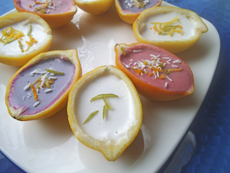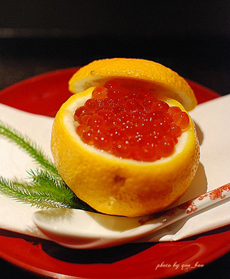TIP OF THE DAY: Reuse Citrus Rinds As Mini Bowls
|
As you cook your way through the holidays, consider saving the shells (whole rinds) of halved, juiced lemons, limes, oranges and grapefruit. You can repurpose them as mini serving bowls—for sides, desserts, condiments and more. First, use a serrated grapefruit spoon or other implement to scrape out the empty juice sacs—but leave the white pith intact. Then cut a tiny slice off from what will become the bottom of each “bowl,” so it will sit flat on a plate. Place the empty shells in the freezer; when frozen, store them in freezer bags. Then, for a festive meal, take them out and use them for: Freeze the entire half, or cut it into quarters. |
TOP PHOTO: Fruit salad. Cut the fruit as fine as it needs to be to fit nicely into the shell. Photo courtesy Elegant Affairs Caterers. MIDDLE PHOTO: These are panna cotta, but could as easily be sauces or sides. Photo courtesy Swirls And Spice. BOTTOM PHOTO: Stuffed with rice and topped with salmon caviar. Photo courtesy Qoo’s Life. |
|
|
Botanically, citrus fruits are berries with leathery rinds. In botany this type of berry is called a hesperidium. The great botanist Carl Linnaeus (1707 – 1778) bestowed the name Hesperideæ to the order the contains the Citrus genus. It’s an allusion to the the Hesperides, nymphs who in Greek and Roman myth guarded a blissful garden of golden apples. From Sweden, Linnaeus was a botanist, zoologist and physician. He laid the foundations for taxonomy, the modern biological naming system for describing species (taxa in Latin). Many of his writings were in Latin, as was custom among scientists of the time. Latin was a common language among educated Europeans, so no matter what one’s native language, one could read the works of others in Latin.
|
||





